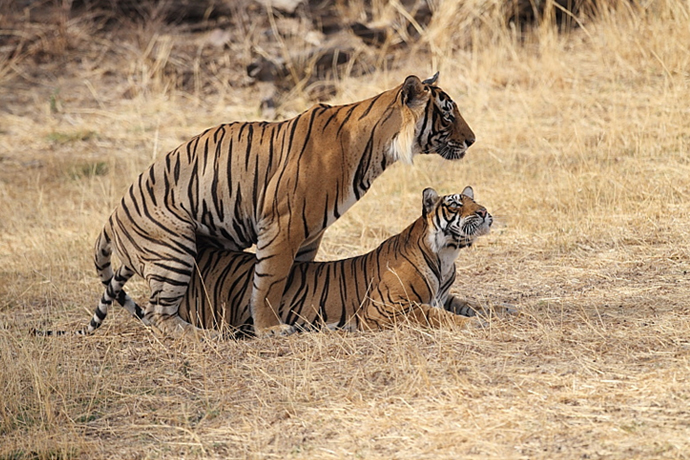Every national park has its own unique character, but there are a special few that just capture your imagination and never let go. My now favorite parks, Ranthambore and Bandhavgarh, are worlds apart, but what is common is that they have both carved out a niche for themselves in my heart and mind. Another distinction they share, interestingly enough, is that of being terrible first visits for me, in 1999 and 2006 respectively. It wasn’t till November 2009 that the reports and pictures that negated my first impression of Ranthambore tempted me enough to go back for a second visit. This trip restored my faith in the concept of delayed gratification – it took the park time to warm up to me, but once it did, we got on like a house on fire.
The atmosphere of this park is unique – it somehow manages to live up to the mystique surrounding its name. The narrow road leading into the park feels like a hallowed hallway, closely flanked on both sides by high cliffs, inviting and preparing you to enter the magical grounds of Ranthambore. Once the hunting ground of the Maharajas of Jaipur, it is dotted with large stone palaces and forts built to stake man’s claim over the land. Today, pervasive plant roots creep their way over the old ruins, the only remnants of an age gone by, now as much a part of the natural landscape as the trees themselves. I felt a sense of awe, of old world mystery, of entering the land of kings. Though the Maharajas of old are gone, they have been replaced by a king even older, reclaiming the wilderness as his own.
November 2009 – The Sub-adult Siblings
Unfortunately, in the first two days of my trip, not even one haughty monarch deigned to turn up. My guide, Vivek Bhargava, fondly called Bobby, and my driver, Ajit Singh, left no stone unturned to track down a tiger, but my first three safaris passed with no sign of one. Oddly enough, this didn’t put me off as much as it could have – the magnetic atmosphere of the park had blown me away. Ranthambore was already in my blood.
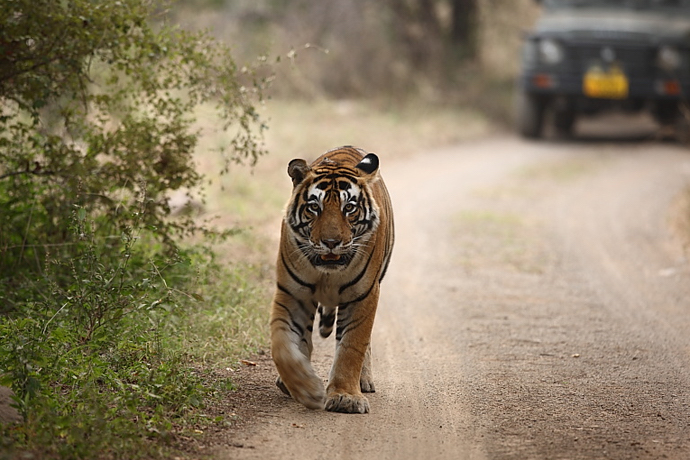
Like the park itself, this duo took a little time to get going, but once they did, I couldn’t have asked for more. They made an excellent team, and their resourcefulness and skills often made the crucial difference between an average sighting and a brilliant one. The perfect example was my encounter with T-12 at Foota Bandha in Zone 2. We were one of the last jeeps to reach the sighting, and crowded as the park is, there was already a huge queue of jeeps and cantors, along which the tiger was tracing a somewhat parallel path. This is where the aptitude showed – Ajit Singh used a truly ingenious combination of cajoling, bullying and driving skills to somehow get us right at the head of the queue. I probably still couldn’t tell you exactly how he did it, but we found ourselves separated from the queue with the magnificent T-12 crossing in the space in between. What a view! The duo’s uncanny ability to achieve results every time earned them my lasting respect and gratitude.
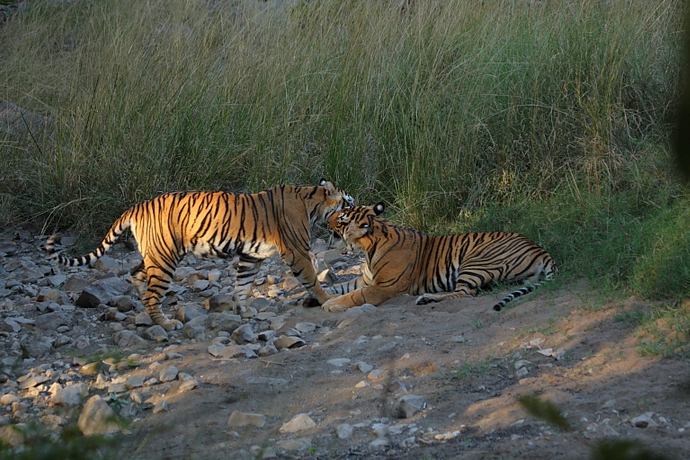
Tigers are opportunistic and adaptive – it is a trait that extends to their hunting methods as well. The usually solitary predators have been known, in areas of sparser vegetation including in Ranthambhore in the 1980s, to hunt cooperatively. A tigress will usually hunt with her cubs till the age of 24-32 months, to teach them how to catch their own prey – but what happens when the cubs lose their mother before reaching adulthood? The star attractions of my November 2009 trip, the brother-sister pair T-40 and T-41, answered the question unusually – they hunt together. The Berda cubs, as they were known then, lost their mother to a territorial fight at the age of 17 months in April 2009. For three to four days consecutively, in Berda in Zone 4, I caught the pair sharing a nilgai they had brought down together. It has been observed that in situations like this, the tiger that makes the kill is the first allowed to feed. Throughout my trip, I watched this pair living co-dependently, and though the caring sibling relationship appealed to my human sensibilities, I hoped that they would soon be living and hunting on their own. As it turns out, they grew into beautiful adults and I was to have another unforgettable sighting with the female T-41. However, tragedy never seems far from these gorgeous creatures – T-40 has been reported missing from the park, along with three other tigers.
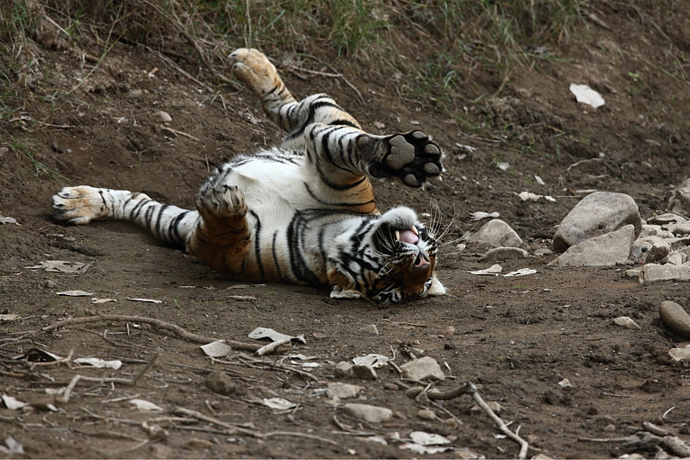
It is not unusual for tigers to die or disappear, but it is unusual for them to live to the ripe old age of 15. Machli, the matriarch of the park, popularly called the Lady of the Lakes is a tigress famous for killing crocodiles. Since her own birth in 1997, Machli (T-16) has given birth to 11 cubs that have survived to adulthood. In years when Ranthambore was reeling from poaching-caused tiger scarcity, Machli stood a bastion, gratifying visitors with sightings that helped keep her species alive in the imaginations of the outside world. Her gift to me was to cross close behind our jeep, emitting a moan, like a subdued roar, perhaps in communication with another hidden tiger. A Ranthambore visit would have been incomplete without her, but luckily for me, the mistress of the establishment played her role as a most gracious hostess.
In April 2010,
I returned to Ranthambore with the same brilliant driver-guide combination, and it rained tigers. People count themselves lucky to catch a single sighting, but Ranthambore showered me with them – 19 sightings in 20 safaris, a 95% success rate. As if that wasn’t enough, those sightings were not the same tiger over and over (though that happened too, and it has a joy of its own), but eleven unique tigers. Eleven! Unfortunately, T-12 had been relocated to Sariska, and I didn’t catch T-40 and T-41 either on that trip. Instead I saw T-2, T-5, T-6, T-7, T-16, T-17, T-22, T-23, T-28, T-38 and T-39. (Count them if you don’t believe me!)
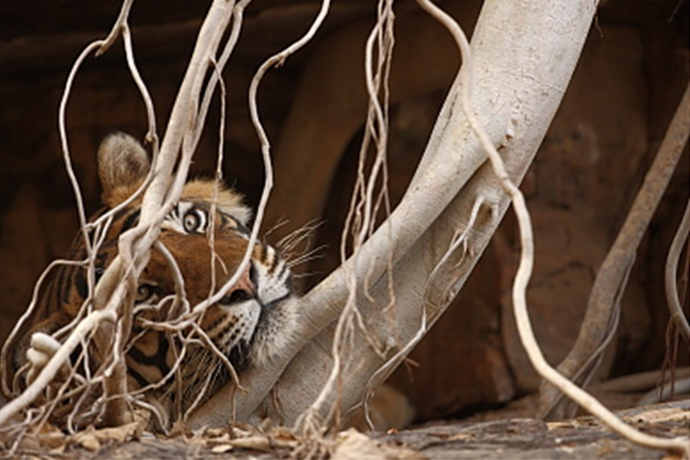
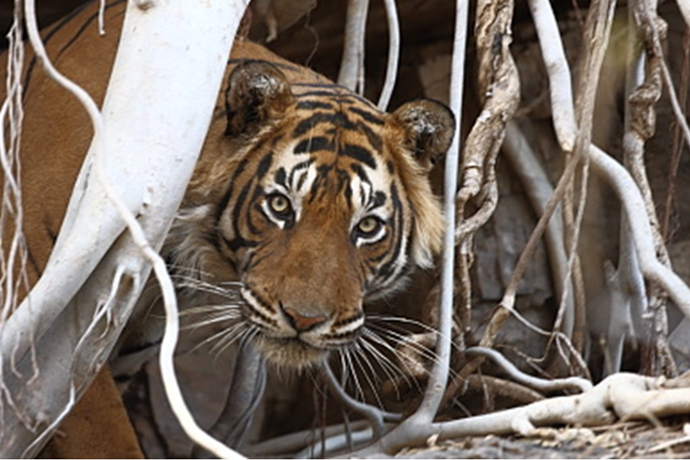
Patience is an indispensable virtue for any serious wildlifer – it is this that got me a couple of particularly interesting pictures last April, but the one and a half hour wait could’ve easily discouraged the faint-hearted. T-23 was peacefully asleep in a cave at Foota Kort in Zone 2, being gawked at by sundry curious spectators, whose ranks I joined. He would occasionally lift his regal head and blink lazily at us, as if to say “Still here? You people need jobs.” I wasn’t complaining – the shots I was getting of him framed his head perfectly between some roots, and when he looked straight at the camera, the light in his light bronze eyes reminded me again why I love doing this.
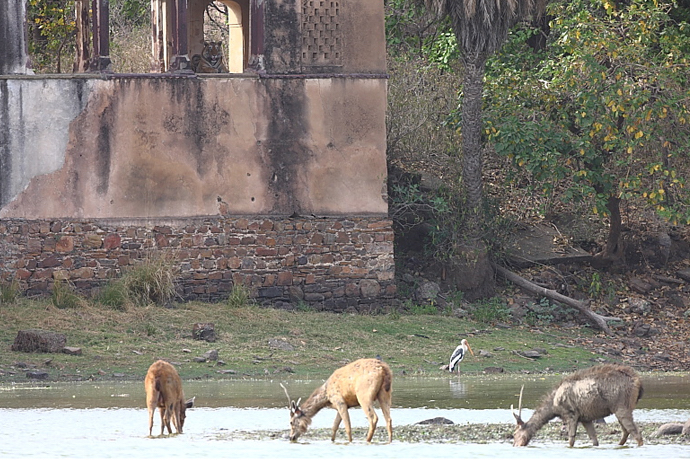
While in the wild, that reminder is never very far away – the sight of a tiger standing amongst ruined old palaces, gloriously reclaiming his land after centuries, has a humbling majesty of its own. T-28 looked every inch the fitting ruler of a vast and varied kingdom, when I saw him under an archway in the old hunting palace, Shikar Gah. The Rajbagh lake below thronged with sambar and painted storks, seeking relief from the blazing heat. As the king chose to walk down the hill exploring his kingdom, his subjects fled in a sudden but not unjustified panic. He sat in the water for a while, needing to cool down just as they did, and then walked along the lake only to reemerge at a spot 1km away where my terrific two had positioned our jeep already. T-28 was called the Star Male, named, like Machli, after distinctive facial markings, but it was also an apt title for a tiger that was the most beautiful I’d seen yet.
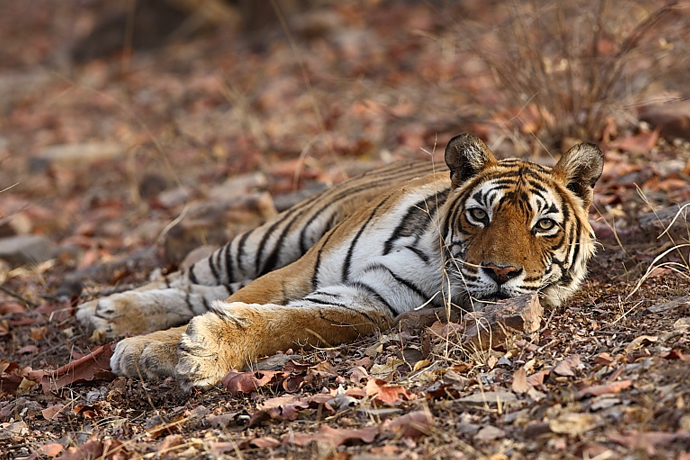
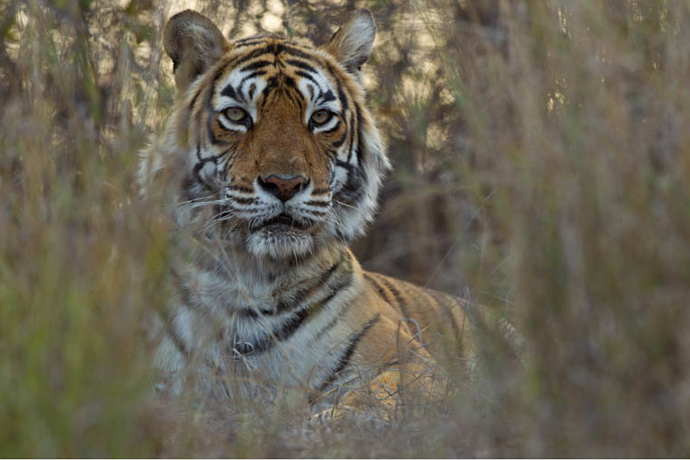
Machli too was a beautiful female, and on this trip, she posed for me like the Tiger Queen that she was once called. Queen no longer, dethroned by her daughter T-17, in an almost soap opera-worthy saga. Even missing three of four canines, eyes reflecting her years and nose blackened with age, Machli retained her air of impeccable grace and haughty elegance. She lay by the side of the road, allowing me to photograph her to my heart’s content, the perfect hostess as always.
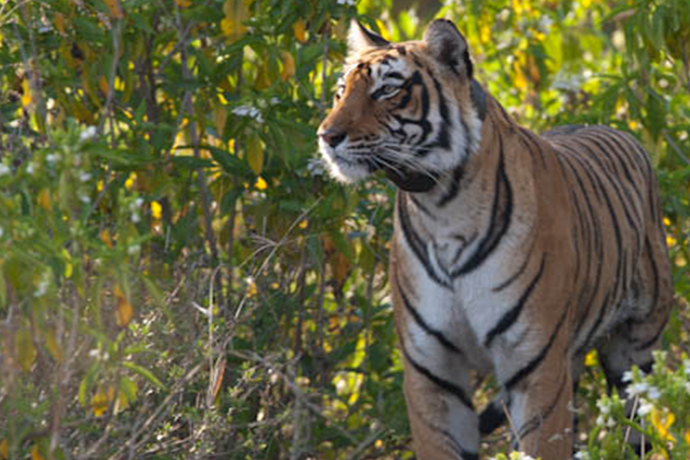
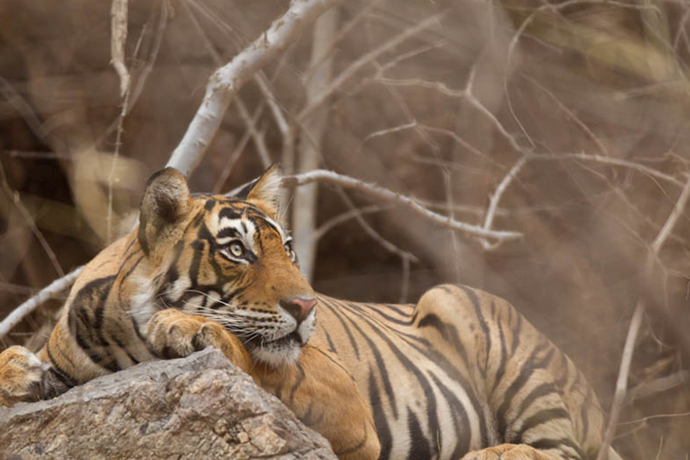
While some sightings were easily granted by obliging tigresses like Machli, others were masterfully contrived, thanks to the acumen of my team and a heavy dollop of good luck. T-38’s camouflage on a knoll in the Sultanpur region was near perfect, but sudden movement on his part and sharp eyesight on mine gave him away. Bobby and Ajit again proved themselves, predicting with remarkable accuracy where he would emerge, and then placing us miraculously close by for a good sighting. He can no longer be found in Ranthambore, but for once it is happy news – in February 2011, he migrated to the Palpur-Kuno Sanctuary, a case of natural dispersal catalyzed by the growing number of males in Ranthambore. He is anticipated to travel further to Madho National Park, where he will find females to continue breeding.
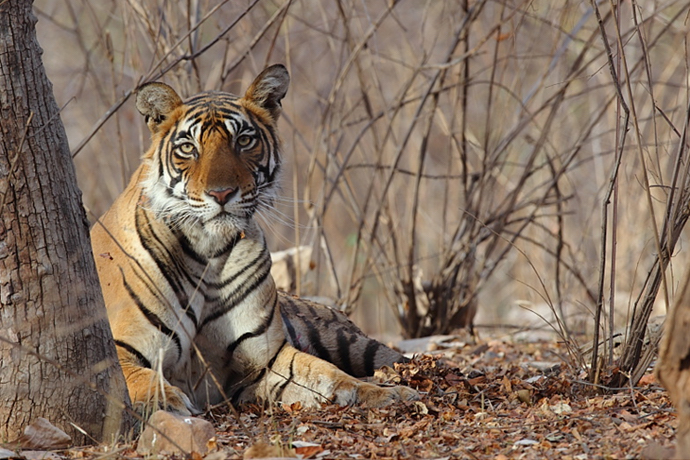
For the keen tiger enthusiast, almost every sighting can provide interesting behavioral insight – either it cements previously known information, or it reveals a new facet of the nature of this elusive animal. I first saw the young tigress T-39 just walking through some undergrowth not too far away. The relatively sparse vegetation in Ranthambore provides less cover for both predator and prey, but in this case it was the herd of sambar nearby who were blissfully unaware of the tigress’ presence. T-39 climbed up the hillock and, much to our fascination, used the height to scope out the herd below. You could almost hear the wheels turning in her head as she carefully evaluated the deer from the perspective of a hearty meal. There were no chases or hunts in store for us though, as she soon came down from her vantage point and walked up close to the jeep. It was one of those glad moments when I saw her again at the exact same spot just about a year later.
March 2011 – T-24
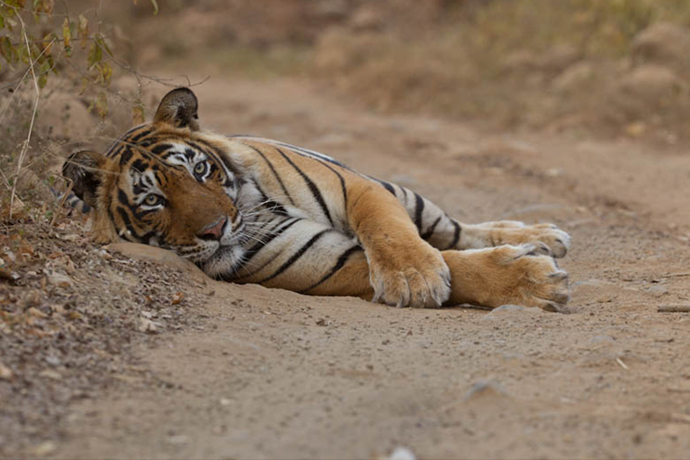
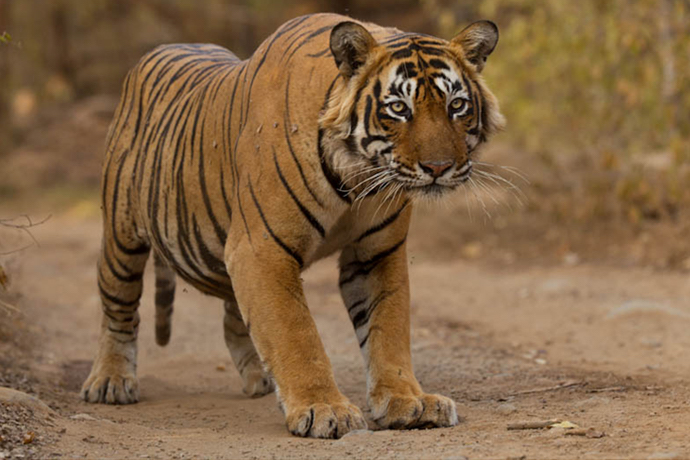
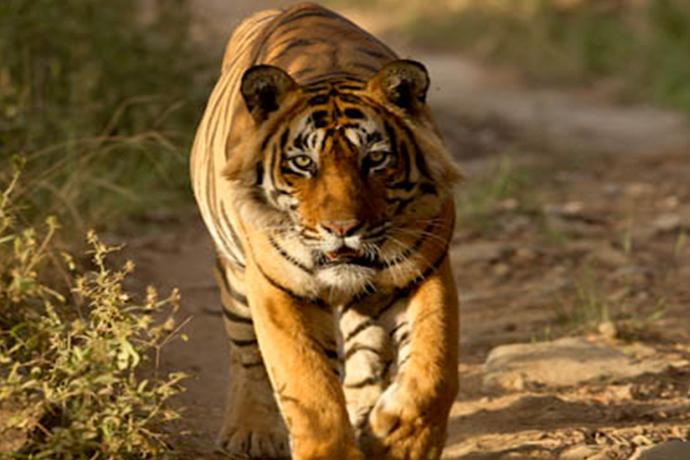
Ranthambore still had lots in store for me – one morning in March 2011, as is my habit, I was out early enough to be the first jeep in the park. It has always paid off, and this time was no exception. As the jeep turned a corner among the forests, crossing the road in front of us was a massive tiger, T-24, the largest tiger in the park. He headed into the undergrowth, and we thought we’d lost him, but he soon reappeared, refusing to deny this early bird its well-deserved worm. For the next half an hour we had him all to ourselves, as he lay down on the road and almost went to sleep, occasionally getting up to make sure that we hadn’t dared to come any closer. In a while, disturbed perhaps by sounds that were lost on us, he got up and began to walk towards the jeep. He forced us to reverse the jeep down the road away from him for nearly 100 m before giving up and heading off into the forest. Later sightings taught me that this was a highly belligerent tiger – usually, if a jeep advances too close, a tiger will step back and snarl defensively, but T-24 was one who would step forward instead and growl assertively. Other jeeps were joining us by this time, and the regular tourist hungama was just beginning, but for me, the best part of the day was already over.
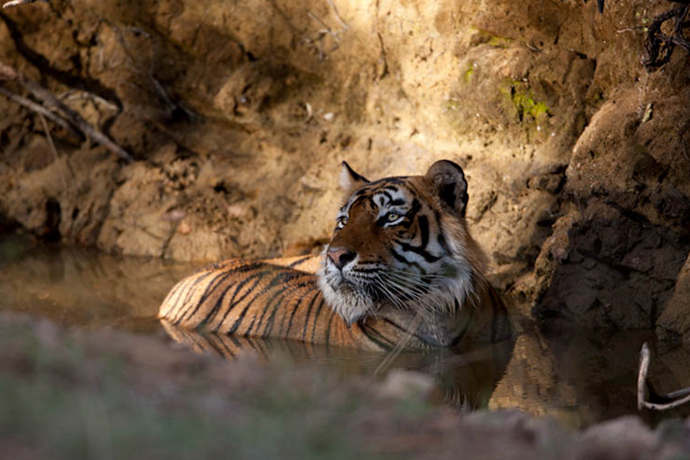
June 2011 – Like popcorn in a microwave
March was not a fruitful month, so I decided to head back there in June, two months ago. Before going, I was worried about the rains, which as it turns out was an entirely misjudged anxiety. Visit Ranthambore in May and June to find out first-hand what popcorn feels like in the microwave. If (and I can’t imagine why) that isn’t your idea of the perfect trip, perhaps this will change your mind – in the dry months there is sparser vegetation, forcing ungulates to gather around watering holes, and when prey comes, can predator be far behind? On 7th June, the recorded temperature was 46.5 degrees Celsius, and I was roaming the forests of Ranthambore, my sympathies with corn growing by the minute. June is also the month of Aashaadha in the Hindu lunar calendar, making the Ganesh Mandir a bustling hotspot for religious tourism. Every Wednesday, the entry road to the park would be packed with devotees heading to pay their respects.
I suppose bearing the heat was a part of the pilgrimage for them, and though religion was not my motivator, I got my rewards as well – I had never before seen tigers mating, and this time I got lucky. T-41, the female, was the same tigress I had seen with her brother earlier and was probably in her first oestrus at the age of 27 months. T-6, the male, gained publicity later as the tiger who was seen stealing from Machli a meal she herself stole from a crocodile. There was a fierce fight between the two, which I was unfortunate enough to miss, even though I was in the park at the time. T-6 had also been suspected of killing a bullock and mauling a forest guard in February 2011. When I saw him though, it was love and not death that was on his mind.
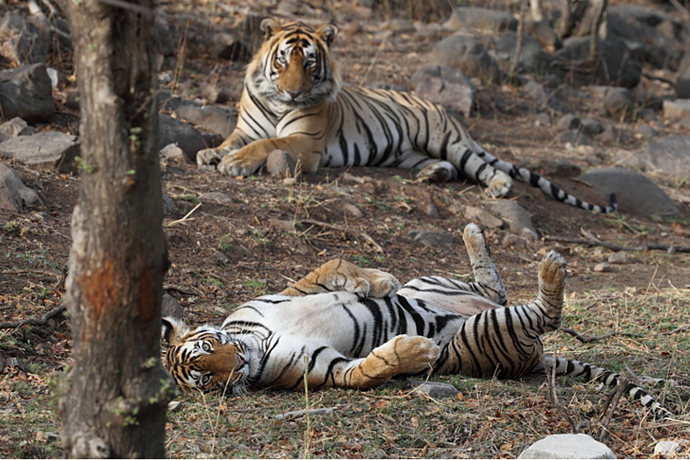
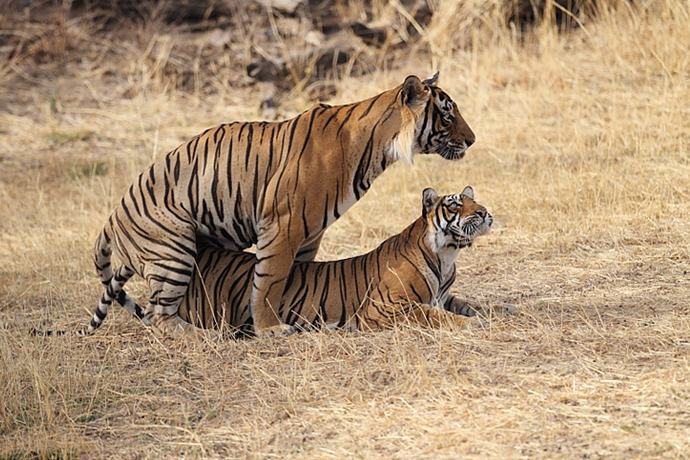
It must have been in the air around that time, because from June 2010 to June 2011, Ranthambore has seen the birth of 18 cubs. It is an unprecedentedly high number, but how many survive to adulthood remains to be seen. “Among the tigresses who have given birth so far are T-5 who eventually died leaving behind the two newborns, tigresses T-13, T-31, T-8 with two cubs each and tigresses T-11, and T-26 with three cubs each,” say forest officials. T-19 has three cubs, which would bring the number to 17, though reports are touting the number 18. While I was not lucky enough to see any cubs myself, I did see the beautiful T-19 while she was clearly lactating. Her cubs themselves, aged 2 and a half to 3 months, were only seen by two cantors. Tourism minister Bina Kak had been among the first notice the lactating tigress in April 2011.
Cubs are a sign of healthy growing populations, a beacon of hope in the bleak conservation landscape. Ranthambore has faced down hunting, poaching, man-tiger conflict, skewed sex ratios and every other problem that a sanctuary can have. It has gone from a tiger population almost decimated, to a higher density than it can comfortably support. It has weathered every storm and still stands as one of the foremost wild tiger sanctuaries in the world. I am blessed to be able to appreciate everything that is Ranthambore, and its tigers have on me a hold that will never be broken.
